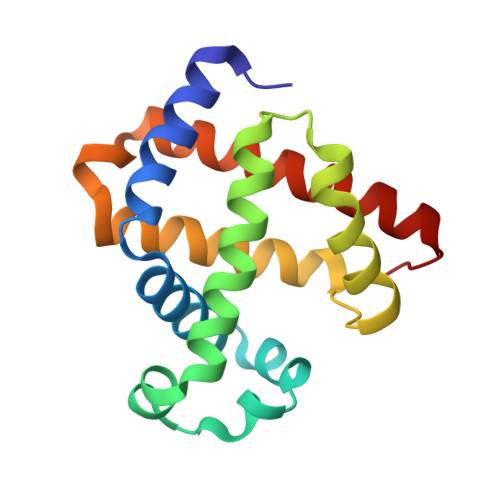Heme redox potentials hold the key to reactivity differences between nitric oxide reductase and heme-copper oxidase.
Bhagi-Damodaran, A., Reed, J.H., Zhu, Q., Shi, Y., Hosseinzadeh, P., Sandoval, B.A., Harnden, K.A., Wang, S., Sponholtz, M.R., Mirts, E.N., Dwaraknath, S., Zhang, Y., Moenne-Loccoz, P., Lu, Y.(2018) Proc Natl Acad Sci U S A 115: 6195-6200
- PubMed: 29802230
- DOI: https://doi.org/10.1073/pnas.1720298115
- Primary Citation of Related Structures:
6D45 - PubMed Abstract:
Despite high structural homology between NO reductases (NORs) and heme-copper oxidases (HCOs), factors governing their reaction specificity remain to be understood. Using a myoglobin-based model of NOR (Fe B Mb) and tuning its heme redox potentials (E°') to cover the native NOR range, through manipulating hydrogen bonding to the proximal histidine ligand and replacing heme b with monoformyl (MF-) or diformyl (DF-) hemes, we herein demonstrate that the E°' holds the key to reactivity differences between NOR and HCO. Detailed electrochemical, kinetic, and vibrational spectroscopic studies, in tandem with density functional theory calculations, demonstrate a strong influence of heme E°' on NO reduction. Decreasing E°' from +148 to -130 mV significantly impacts electronic properties of the NOR mimics, resulting in 180- and 633-fold enhancements in NO association and heme-nitrosyl decay rates, respectively. Our results indicate that NORs exhibit finely tuned E°' that maximizes their enzymatic efficiency and helps achieve a balance between opposite factors: fast NO binding and decay of dinitrosyl species facilitated by low E°' and fast electron transfer facilitated by high E°'. Only when E°' is optimally tuned in Fe B Mb(MF-heme) for NO binding, heme-nitrosyl decay, and electron transfer does the protein achieve multiple (>35) turnovers, previously not achieved by synthetic or enzyme-based NOR models. This also explains a long-standing question in bioenergetics of selective cross-reactivity in HCOs. Only HCOs with heme E°' in a similar range as NORs (between -59 and 200 mV) exhibit NOR reactivity. Thus, our work demonstrates efficient tuning of E°' in various metalloproteins for their optimal functionality.
- Department of Chemistry, University of Illinois at Urbana-Champaign, Urbana, IL 61801.
Organizational Affiliation:

















